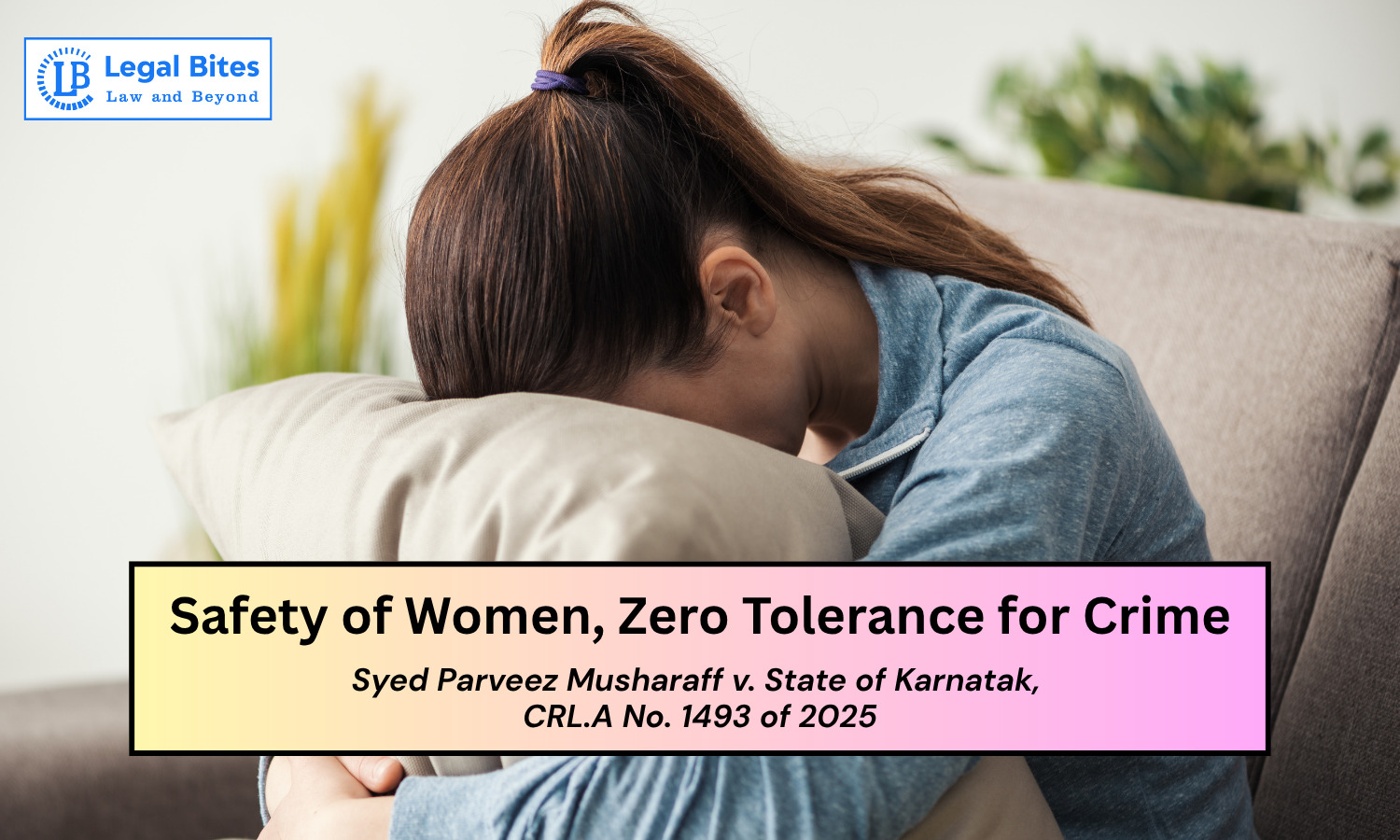
Karnataka High Court, in Syed Parveez Musharaff v. State of Karnataka (CRL.A No. 1493 of 2025, decided on 4 September 2025), refused to grant bail to an accused charged with facilitating rape under the Bharatiya Nyaya Sanhita (BNS), 2023 and provisions of the Scheduled Castes and Scheduled Tribes (Prevention of Atrocities) Act, 1989 (SC/ST Act).
Justice S. Rachaiah, while dismissing the appeal, highlighted that crimes against women leave permanent scars and the judiciary cannot afford leniency in such matters. Strikingly, the Court cited a shloka from Manusmriti and a profound observation by Mahatma Gandhi to emphasise the centrality of women’s dignity to societal progress and India’s idea of independence.
This article examines the factual background, legal arguments, judicial reasoning, and broader implications of this judgment. It also reflects on how the judiciary blends constitutional values with cultural ethos in combating gender-based crimes.
Factual Background
- On 2 April 2025, around 1:30 a.m., the victim, a 19-year-old woman, arrived at K.R. Puram Railway Station, Bengaluru, after travelling from Ernakulam as per family instructions. She was accompanied by her cousin brother (C.W.2).
- While heading towards Mahadevapura for food, they were wrongfully restrained by two accused. The victim was forcibly taken aside by accused No.1, who committed rape on her, while accused No.2 (the appellant) restrained her cousin and threatened him to prevent resistance.
- The victim raised an alarm, attracting public attention. The crowd managed to apprehend one of the accused, while the police intervened and registered a case.
The offences charged included:
Sections 115(2), 126(2), 351(2), 351(3), 352, 64 r/w Section 3(5) of BNS, 2023
Sections 3(1)(r), 3(1)(w)(i)(ii), 3(2)(v) of the SC/ST Act, 1989
- The appellant (accused No.2) sought regular bail, claiming innocence and denying direct involvement in the rape.
Arguments Before the Court
Appellant’s Counsel
- The appellant was only alleged to have restrained the victim’s cousin and did not commit rape.
- His role was limited, and he should not be equated with Accused No. 1.
- He was falsely implicated and should be released on bail.
State’s Counsel (Addl. SPP)
- The appellant actively facilitated the commission of rape by restraining the victim’s cousin.
- His conduct amounted to deliberate participation in the heinous offence.
- Granting bail would send a wrong signal to society, undermine women’s security, and erode public confidence in the justice system.
Judicial Reasoning
1. Parameters for Grant of Bail
Justice Rachaiah reiterated the settled principles for bail:
- Nature of accusation and severity of punishment
- Likelihood of tampering with witnesses or threatening the complainant
- Prima facie satisfaction of the court
While liberty is a fundamental right, it must be balanced against societal interest and the gravity of offences, especially when involving vulnerable victims.
2. Heinousness of the Offence
The Court noted that:
- The victim was a young woman with aspirations for her future.
- The crime inflicted “a scar” that she would carry throughout life.
- The appellant’s role was not minor; he intentionally aided the crime by restraining the victim’s protector (her cousin).
Thus, the appellant’s conduct was not a passive presence but an active facilitation of rape.
3. Invocation of Cultural and Ethical Values
To reinforce the seriousness of protecting women, Justice Rachaiah drew from ancient and modern wisdom:
Manusmriti shloka:
“Yatra naryastu pujyante ramante tatra Devata, yatraitaastu na pujyante sarvaastatrafalaah kriyaah.”
(Where women are honoured, divinity blossoms; where dishonoured, all acts, however noble, remain unfruitful.)
Mahatma Gandhi’s words on freedom:
“The day a woman can walk freely on the road at night, that day we can say that India has achieved independence.”
By invoking these, the Court emphasised that crimes against women strike at the moral core of Indian civilisation and obstruct the realisation of true independence.
4. Rejection of Bail
Given the seriousness of the offence, the societal impact, and the constitutional commitment to gender justice, the Court dismissed the bail plea, holding that leniency would compromise public confidence in the justice system.
Broader Implications of the Judgment
- Women’s Dignity as Core to Justice: The Court reaffirmed that crimes against women are not just personal wrongs but social evils that erode collective dignity. Judicial decisions must therefore send a strong message of deterrence.
- Balancing Liberty and Accountability: While bail is the rule and jail the exception, in cases involving sexual violence, courts lean toward the protection of victims and society over the accused’s liberty.
- Integration of Cultural-Ethical References in Judicial Discourse: By citing Manusmriti and Gandhiji, the Court bridged ancient scriptures, modern nationalist ideals, and constitutional morality—creating a moral-legal continuum in gender justice jurisprudence.
- Reinforcement of SC/ST (POA) Act Protections: The invocation of the SC/ST Act provisions underscored that crimes against women from marginalised communities attract heightened scrutiny due to compounded vulnerability.
Conclusion
Karnataka High Court’s refusal to grant bail in Syed Parveez Musharaff v. State of Karnataka exemplifies the judiciary’s firm approach to crimes against women. By quoting the Manusmriti and Gandhiji, the Court highlighted that women’s dignity is both a civilizational value and a constitutional mandate.
This case is significant not merely for its outcome but for its broader message: a society that dishonours women undermines its own foundations of justice, morality, and independence.
The judgment underscores that liberty cannot be extended at the cost of women’s safety. As Gandhiji envisioned, true freedom is realised only when every woman feels safe, even in the darkest hours of the night. Until then, the law must remain uncompromising in safeguarding her dignity.
Important Link
Law Library: Notes and Study Material for LLB, LLM, Judiciary, and Entrance Exams